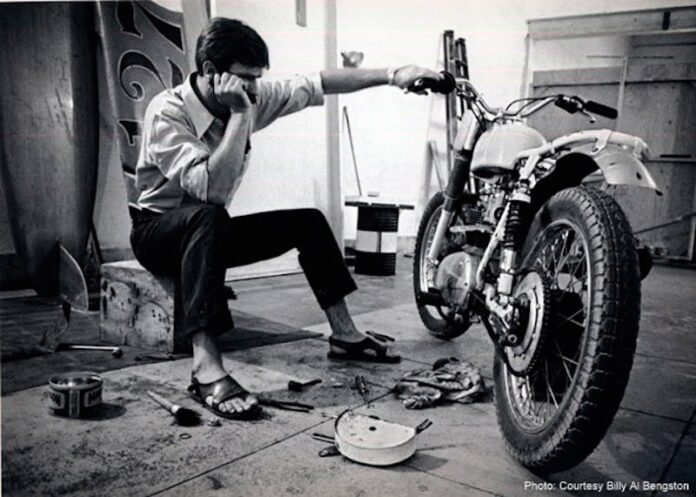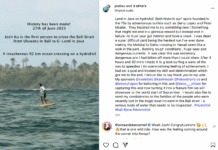A Hanukah miracle!
Surfer, motorcycle racer, artist, hep-cat, and co-founder of The Royal Hawaiian crowd-clearing technique at Malibu, Billy al Bengsto, is safe and sound and back with his family, although details are thin as to where he disappeared to and why.

Pretty much the only information that Bengston was home was one Instagram post announcing WE FOUND HIM!!!! by “Bluetica” on the last day of November, 2021.
An appeal to “Bluetica” for details came up with bupkis and that led to an internet search to discover who “Bluetica” is.
“Bluetica Bengston” got mixed results from Los Angeles to Rome, but it appeared there was a Blue Tica Bengston who was involved with the horsey and polo set in Santa Barbara.
A Google search for “daughter Billy Al Bengston” was revealing, as apparently this was not the first time Moondoggie split from Venice.
According to a story called Venice is losing a bit of its cool by Lousie Roug in The Los Angeles Times for 8-8-2004, Bengston was retiring and splitting from Venice to move to British Columbia,
“In mid-August, he’s moving to Victoria, Canada, with his wife, Wendy, and his 14-year-old daughter, Tica – a move prompted, he said, by Tica, who wants to live in ‘horse country.’”
So that was her, a daughter born in 1990 who was into horses. So that was revealing but more so about how an influential artist from the 1950s and 1960s was negotiating the years on either side of Y2K.
According to The LA Times, Bengston’s departure was seen as the end of an era and bad juju by the resident artists of Venice:
But by the early ‘90s, Bengston had nearly vanished from the art scene, showing intermittently and then, for long stretches, not at all. His friends developed theories: Bengston had given up on the art world, or the art world had given up on Bengston; he was a victim of changing sensibilities, or he had opted out of a corrupt system.
Bengston himself gave contradictory answers. ‘Billy Al is retired and in his retirement, doing all the things one shouldn’t do while retired,’ his website said.
Now, a show of old and new work, ceramics and paintings opens today at the Cartelle Gallery in Marina Del Rey.
The show is a farewell to Los Angeles. Billy Al Bengston, contrarian, is leaving town.
Matt Kivlin was done with surfing in the 1950s: “Too crowded” and went on to be an admirably prolific architect, working non stop as Los Angeles boomed after World War II.
Bengston also thrived as a post-war artist, but it took him longer than that to be over the art world, which he compared to the surfing world.
Later on in the article, Bengston found parallel lines between the surfing world of the 50s and the art world of the 1950s:
On a lazy summer morning, Bengston’s view was a Southern California tableau: An ocean breeze rustled the palm trees in his garden and rippled the surface of the pool. But Bengston was happy to be leaving it all behind.
“I’m so thankful I’m not young and having to do it the way they do it today,” he said. “It was a lifestyle when we used to do it. Surfing absolutely paralleled the art world: It used to be a lifestyle, it became a business. When things become a business, your values change. There was no dollar value in surfing, and there was no dollar value in being an artist.”
The real value of art, he said, is mystery and surprise.
“A work of art is always supposed to leave you, ‘I don’t understand that. But it sure isn’t boring,’” Bengston said.
The only function of art is to be “something that you ain’t seen before,” he said. “To be itself.”
If you’re interested, that Los Angeles Times article is a good biography of Bengston up to 2004, when Bengston apparently bailed to British Columbia.
At some point he came back, and then, more recently, he disappeared again.
Information on that is non-existent. But safe to say, Billy Al is safe and sound and bouncing babies.
Home for the holidays.





